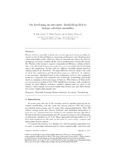Mostrar o rexistro simple do ítem
On developing an automatic threshold applied to feature selection ensembles
| dc.contributor.author | Seijo Pardo, Borja | |
| dc.contributor.author | Bolón-Canedo, Verónica | |
| dc.contributor.author | Alonso-Betanzos, Amparo | |
| dc.date.accessioned | 2023-12-04T14:30:14Z | |
| dc.date.available | 2023-12-04T14:30:14Z | |
| dc.date.issued | 2019-01 | |
| dc.identifier.citation | B. Seijo-Pardo, V. Bolón-Canedo, y A. Alonso-Betanzos, «On developing an automatic threshold applied to feature selection ensembles», Information Fusion, vol. 45, pp. 227-245, ene. 2019, https://doi.org/10.1016/j.inffus.2018.02.007 | es_ES |
| dc.identifier.issn | 1566-2535 | |
| dc.identifier.uri | http://hdl.handle.net/2183/34421 | |
| dc.description | © 2019. This manuscript version is made available under the CC-BY-NC-ND 4.0 license https://creativecommons.org/licenses/by-nc-nd/4.0/. This version of the article "R.-J. Palma-Mendoza, L. de-Marcos, D. Rodriguez, y A. Alonso-Betanzos, «B. Seijo-Pardo, V. Bolón-Canedo, y A. Alonso-Betanzos, «On developing an automatic threshold applied to feature selection ensembles», Information Fusion, vol. 45, pp. 227-245, ene. 2019" has been accepted for publication in Information Fusion. The Version of Record is available online at https://doi.org/10.1016/j.inffus.2018.02.007 | es_ES |
| dc.description.abstract | [Abstract]: Feature selection ensemble methods are a recent approach aiming at adding diversity in sets of selected features, improving performance and obtaining more robust and stable results. However, using an ensemble introduces the need for an aggregation step to combine all the output methods that confirm the ensemble. Besides, when trying to improve computational efficiency, ranking methods that order all initial features are preferred, and so an additional thresholding step is also mandatory. In this work two different ensemble designs based on ranking methods are described. The main difference between them is the order in which the combination and thresholding steps are performed. In addition, a new automatic threshold based on the combination of three data complexity measures is proposed and compared with traditional thresholding approaches based on retaining a fixed percentage of features. The behavior of these methods was tested, according to the SVM classification accuracy, with satisfactory results, for three different scenarios: synthetic datasets and two types of real datasets (where sample size is much higher than feature size, and where feature size is much higher than sample size). | es_ES |
| dc.description.sponsorship | This research has been financially supported in part by the Spanish Ministerio de Economa y Competitividad (research project TIN 2015-65069-C2-1-R), by the Xunta de Galicia (research projects GRC2014/035 and the Centro Singular de Investigación de Galicia, accreditation 2016–2019) and by the European Union (FEDER/ERDF). | es_ES |
| dc.description.sponsorship | Xunta de Galicia; GRC2014/035 | es_ES |
| dc.language.iso | eng | es_ES |
| dc.publisher | Elsevier | es_ES |
| dc.relation | info:eu-repo/grantAgreement/MINECO/Plan Estatal de Investigación Científica y Técnica y de Innovación 2013-2016/TIN2015-65069-C2-1-R/ES/ALGORITMOS ESCALABLES DE APRENDIZAJE COMPUTACIONAL: MAS ALLA DE LA CLASIFICACION Y LA REGRESION | es_ES |
| dc.relation.uri | https://doi.org/10.1016/j.inffus.2018.02.007 | es_ES |
| dc.rights | Atribución-NoComercial-SinDerivadas 3.0 España | es_ES |
| dc.rights.uri | http://creativecommons.org/licenses/by-nc-nd/3.0/es/ | * |
| dc.subject | Ensemble learning | es_ES |
| dc.subject | Feature selection | es_ES |
| dc.subject | Automatic thresholding | es_ES |
| dc.title | On developing an automatic threshold applied to feature selection ensembles | es_ES |
| dc.type | info:eu-repo/semantics/article | es_ES |
| dc.rights.access | info:eu-repo/semantics/openAccess | es_ES |
| UDC.journalTitle | Information Fusion | es_ES |
| UDC.issue | 45 | es_ES |
| UDC.startPage | 227 | es_ES |
| UDC.endPage | 245 | es_ES |
Ficheiros no ítem
Este ítem aparece na(s) seguinte(s) colección(s)
-
GI-LIDIA - Artigos [65]






